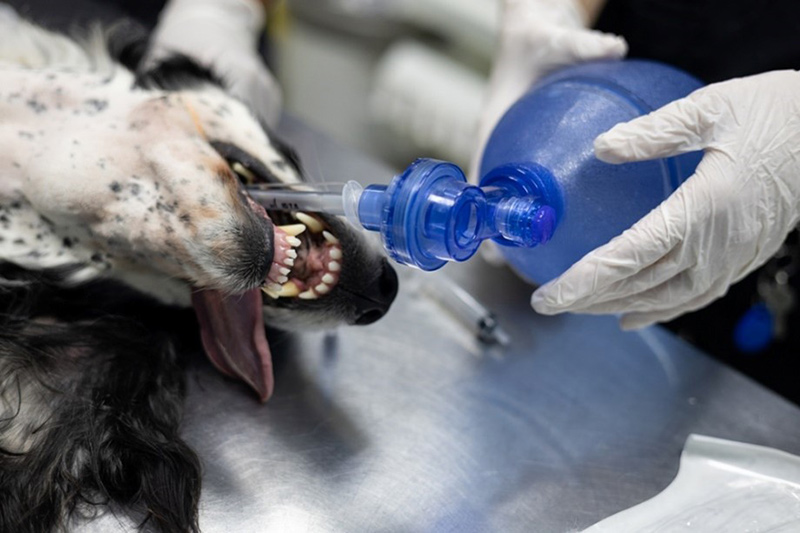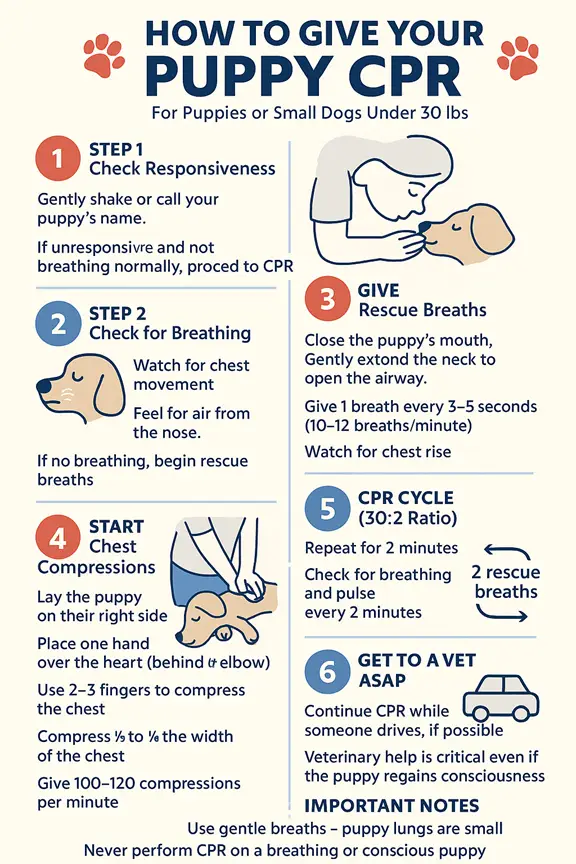
Updated: August 21, 2025
You adore your pets and will go to great lengths to make sure they are healthy, happy, and comfortable. You’ve found the right foods, the right grooming routine, and the right toys to keep them active, but have you considered how you might respond in the event of an emergency?
What would you do if your pet suddenly stopped breathing? Yes, you might call your vet or local animal hospital. Without additional intervention, however, it might be too late to make a difference. Therein lies the need for pet CPR, an adapted version of cardiopulmonary resuscitation, meant to maintain oxygenation and blood flow in the event of cardiac arrest.
While pet CPR holds much in common with the human equivalent, there are some significant distinctions worth noting. It’s important to master this skill so in the event of an emergency, you feel fully prepared to provide life-saving care. In this guide, we will explain how to give your pet CPR while also explaining when and why you might need to perform CPR on pets.
How to Perform Pet CPR
First things first: confirm the scene is safe before administering CPR. Just as important: contacting an animal hospital. Ideally, somebody else can call for help while you focus exclusively on providing CPR.
Next, consider placement. Most dogs will need to be situated on their right side during CPR, although some flat-chested dogs can be placed on their back.[1] With these essentials covered, you can proceed by following these key steps:
1. Check Responsiveness and Airway
Confirm that your pet actually needs CPR. You should never perform chest compressions on a conscious or responsive animal. Observe closely for signs of movement and, if safe, lightly shake your pet.
Next, check your pet’s airway to determine whether there may be a blockage. Do this by gently opening your pet’s mouth and pulling their tongue forward. This will help you see the back of the throat. Look for any signs of food and debris. If this can be safely retrieved, try to remove it without accidentally pushing it deeper.[2]
2. Give Rescue Breaths
Once you feel confident that your pet’s airway is clear, you can move forward with rescue breaths. Begin by closing your pet’s snout. Leave the tongue out to ensure the airway remains clear. Any rescue breaths will involve your pet’s snout. Give two rescue breaths directly into the snout and then check for your pet’s pulse.
If there is a pulse present but your pet is not breathing, you can continue to give rescue breaths (using the snout) every five seconds. If there is no pulse, you’ll need to begin administering chest compressions.
3. Begin Chest Compressions
A reminder that most dogs should be placed on their right side during CPR. This is especially important when performing chest compressions. Be mindful of hand placement. This would be near the widest part of the rib cage for medium or large dogs, but directly over the heart for smaller dogs or cats. Flat-chested dogs should remain on their back, with both hands placed at the chest’s midpoint.
The current recommendations for CPR on pets involve thirty compressions followed by two breaths.[3] For a larger dog, kneel behind and place the palm of your hand on top, using one hand above the other if necessary.
Aim to compress approximately one-third (or even one-half) of the width of your pet’s chest. Most people do not perform deep enough chest compressions so, when in doubt, you can usually aim for greater depth.
4. Continue CPR Cycles
Continue the previously described thirty-compression, two-breath pattern for two minutes and then check for a heartbeat. If the heartbeat has yet to return, continue the same CPR pattern until additional help is available. This may involve one person performing CPR while the other drives, although, depending on the location, emergency pet transport may be available.

How to Perform Puppy CPR When There’s No Pulse
Infant CPR looks a bit different from the type of CPR administered to adolescents or adults — and the same principle holds true when learning how to give a small dog CPR. With puppies or small breeds, sizing determines hand placement and may also influence rescue breathing techniques or even the placement of the person administering CPR.
Ensure the Airway Is Clear
As with larger or older dogs, the first step involves clearing the airway. This will look similar to the process described above. This means checking for signs of responsiveness before opening your pet’s mouth, pulling the tongue forward, looking for signs of debris, and removing blockages if possible.
Position for Breathing and Rescue Breaths
With small dogs, rescue breathing involves more than just the snout. Instead, give two rescue breaths into the nose and mouth. Check for a pulse, and if this is not present, prepare to administer CPR.
Experts recommend that, when possible, “dogs and cats should be intubated with a cuffed endotracheal tube.” While this will not be realistic for the average pet owner, these insights underscore the value of maintaining a clear airway.
Perform Compressions
Place one hand underneath small animals to provide additional support. With small animals, the person performing CPR is placed in front of the recipient and not behind. Often, it is necessary to use two or three fingers to perform compressions, as opposed to an entire hand.
How to Perform CPR on Newborn Puppies
Newborn puppies are vulnerable, so techniques that work well for adults or even older puppies could be downright dangerous just after birth. Thankfully, human intervention is rarely required after birth. Emergency critical care veterinarian Tom Towey tells Veterinary Practice, “Maternal instincts are sufficient to revive a vigorous newborn,” although, in cases involving an obstructed labor (known as dystocia), human intervention may prove necessary.
Towey clarifies that, in emergency situations, the often-used ‘ABC’ acronym still rings true: focus on airway, breathing, and circulation. With newborns, this is best accomplished by following these steps:
Remove Membranes/Fluid
With newborn puppies, clearing the airway largely involves removing fluid or membranes. If these are blocking the nose, wipe them away gently. A clean, soft towel should do the trick, although, for precise dabbing, gauze squares can also be helpful.
Drain Fluid (If present) and Suction (If needed)
Continue to clear the airway, taking extra steps beyond dabbing or wiping, if needed. If possible, use a bulb syringe to suction fluid away from the newborn puppy’s mouth. Marty Greer, DVM recommends a Delee mucus trap for thin, watery fluid, while the bulb syringe proves more helpful when fluid is thick or mucusy.[4] Be sure to pull the tongue forward to help clear the puppy’s airway.
Veterinarian Tom Towey recommends avoiding mechanical suction, as this could damage delicate tissues. Newborns can be tilted to raise their hindquarters, allowing gravity to assist in draining fluids. Sometimes, rubbing the fur with a towel promotes spontaneous breathing.[5]
Mouth-to-Snout Rescue Breaths
As with puppy CPR, rescue breaths for a newborn will involve both the mouth and the snout. Focus on providing tiny puffs of air to accommodate the newborn puppy’s small lungs. Rescue breaths can be provided at a rate of one breath every three seconds. Specifically, Towey recommends fifteen to thirty rescue breaths per minute.
Check for a Heartbeat and Compressions
With newborns, gentle compressions are key. Towey explains that these compressions should be “performed with a thumb and forefinger at 120 beats per minute,” adding that these should “compress the thorax by a third to a half of its width.” The key ratio for newborns? One rescue breath for every four compressions.
Important Reminders When Performing Pet CPR
Now that you know how to give a dog CPR, it’s important to clarify the importance of remaining prompt, gentle, and collaborative while providing emergency care. These suggestions should help:
Act Quickly
With CPR, every minute matters. The longer you wait, the less of a chance you have of successfully resuscitating your pet. This is why it’s so important to learn how to give CPR to a dog well in advance.
Be Gentle
Extra pressure will not always yield better results. A lot depends on the size of the dog, of course, and, with larger dogs, deeper compressions are generally better. When clearing the airway or performing compressions on a smaller dog, however, a gentler approach is preferable.
Teamwork
Depending on the situation, you may be surrounded by other people when your pet requires CPR. Work as a team to improve quality of care. This might mean sending one person to contact the vet or animal hospital, while somebody else is prepared to take over after a two-minute cycle of chest compressions. These rotations are important because it can be easy to get fatigued when performing chest compressions, especially when administering CPR on large dogs.
Professional Help
Do not assume that, because you know how to give CPR to a dog, all will be well once a pulse is restored. Your pet will still need professional attention. Hence, the clear focus on calling an animal hospital as soon as possible and getting help with transporting your pet.
Pet CPR Course
Reading about pet CPR can be helpful, but you won’t truly understand how to give your pet CPR until you’ve gained hands-on experience. This is best achieved by taking a dedicated pet CPR course.
The ideal course will simulate emergency situations so you can practice performing rescue breaths and chest compressions with proper timing and depth. Along the way, you will receive real-time feedback so you can improve your technique. Consider seeking additional training periodically, as CPR guidelines are frequently updated.[6]
Success Rate of Pet CPR
Performed correctly, CPR can produce impressive outcomes — but unfortunately, many people remain unfamiliar with pet CPR or do not know how to administer it correctly. Even when performed in the hospital, this technique cannot guarantee survival, as many other factors influence outcomes.
Survival to Hospital Discharge
The phrase “survival to discharge” reveals whether, upon suffering cardiopulmonary arrest and receiving CPR, patients are not only resuscitated but also able to leave the hospital alive. Sadly, fewer than six percent of dogs experiencing cardiopulmonary arrest (CPA) survive to hospital discharge. The survival rate for humans facing similar circumstances exceeds twenty percent.[7]
Return of Spontaneous Circulation (ROSC)
Return of Spontaneous Circulation (ROSC) reveals whether a sustained heartbeat returns following cardiac arrest and after CPR is administered. Research published in the Journal of Veterinary Medical Science suggests that, when following guidelines highlighted in the RECOVER (Reassessment Campaign on Veterinary Resuscitation) initiative, 43 percent of dogs achieve ROSC after CPA.[8]
Learn Life-Saving Techniques With the Veterinary Programs at Carrington College
As a veterinary assistant or veterinary technician, you can make a dramatic difference in the lives of the pets you care for and the humans who love these four-legged friends. Carrington College can introduce you to the trusted techniques that make all the difference in the modern veterinary environment. Get in touch to learn more about our Veterinary Assisting/Veterinary Assistant and Veterinary Technology programs.
Sources:
[1] American Veterinary Medical Association. “First aid tips for pet owners.” https://www.avma.org/resources-tools/pet-owners/emergencycare/first-aid-tips-pet-owners
[2] Good Morning America. “How to perform CPR on your dog or cat.” https://www.youtube.com/watch?v=11d88s_iEUk&pp=0gcJCdgAo7VqN5tD
[3] American Red Cross. “Pet CPR.” https://www.redcross.org/take-a-class/cpr/performing-cpr/pet-cpr?srsltid=AfmBOoogWaeffugAqVXwIK33lAe0djOQJrqtKstvICryA9Bh4UXqi9_B
[4] Greer, M. “Newborn Puppy Care: The First Breath and Beyond Webinar.” Revival Animal Health. https://www.revivalanimal.com/learning-center/newborn-puppy-care-the-first-breath-and-beyond-webinar?srsltid=AfmBOooQZlSoY_RYcx03WqZ9D_V5yqn6G301ipVBtJ2a3wkT7zxAY6xE
[5] Towey, T. “Newborn resuscitation following dystocia or caesarean section.” Veterinary Practice. https://www.veterinary-practice.com/article/newborn-resuscitation
[6] Larkin, M. “Revised CPR guidelines in dogs, cats emphasize speed, standard techniques.” American Veterinary Medical Association. https://www.avma.org/news/revised-cpr-guidelines-dogs-cats-emphasize-speed-standard-techniques
[7] Reassessment Campaign on Veterinary Resuscitation (RECOVER) Initiative. “2024 RECOVER Guidelines.” https://recoverinitiative.org/2024-guidelines/
[8] Kawase, K. et al. “Clinical outcome of canine cardiopulmonary resuscitation following the RECOVER clinical guidelines at a Japanese nighttime animal hospital.” Journal of Veterinary Medical Science. https://pubmed.ncbi.nlm.nih.gov/29375087/



